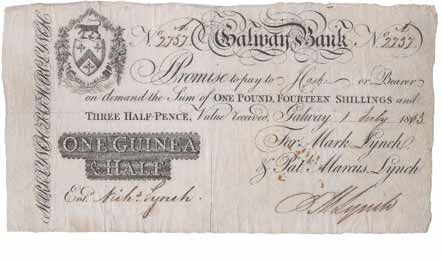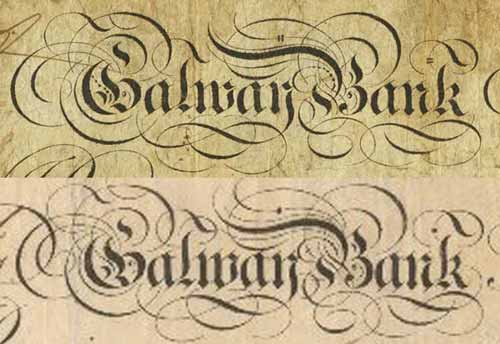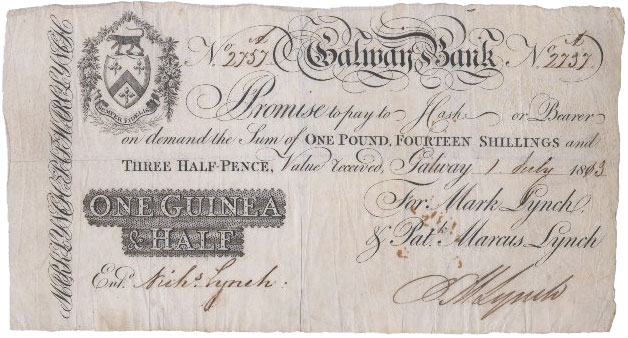

Mark Lynch, who was originally in partnership with Walter Joyce in Galway, set up his own bank in the city which he also named Galway Bank. The year in which the bank was founded is unclear but the presence of his name on the notes of Walter Joyce in 1804 and absence in 1807 suggests that Lynch set up his bank in either 1805 or 1806.
Little is known of Lynch's bank and its operations. It was likely a smaller bank. Banknotes form the bank are rare, suggesting that most of its issue may have been fully redeemed. The Bank closed in the same year as Joyce's Bank, probably as a result of runs on it after the turmoil surrounding the collapse of Ffrench’s Bank in June 1814.
Although listed in Watson’s Almanac until 1816, it is likely to have failed in late 1814 or early 1815. Kenny and Turner (2019) have put the bank’s failure in early 1815 [2].
There is a record of Lynch having stopped payment in February 1815, and going to court to file for bankruptcy in a manner which would be best for both himself and his creditors. The failure of Ffrench’s and the subsequent handling of the bankruptcy of that bank had been catastrophic for its creditors, with much of the assets being taken up in legal fees. Preventing a repeat of this may have been on Lynch’s mind.
The bank issued banknotes and post bills, both of which are rare.
One Series of notes known for Lynch's Bank
There is one Series by design and one Type by partnership. Other series and partnerships are likely.
One Type by partnership.
Type A. 1807-1815. Mark Lynch, Patrick Marcus Lynch.
Denominations recorded: Banknotes: 1 Guinea and a half. Post bills: £10. Others likely.
Printers: unknown.
Notes were printed uniface. The Lynch family arm was used as the bank's symbol on notes. Few notes have been seen of Lynch's bank. No post bills have been seen.

An interesting observation is that the engraving of 'Galway Bank' on some notes of Lynch's bank, dated 1813 is very similar to that on some of the notes printed for Joyce's bank. This is illustrated below. The engraving on top is of a surviving unissued 30 Shilling Joyce-Blake note (1810-1815) which is also used on issued One Guinea notes dated in 1813, and below it is from an issued Lynch's note for One Guinea and Half which was printed before 1810.
Whether this similarity in design indicates that the printers were using the same elements of the printing plates for both banks, or that there might have been a co-operation of some kind between the two banks remains to be investigated. Other design elements of these notes are not especially similar.
30 Shilling notes of a different design with a date in 1813 have been recorded from the Joyce-Blake partnership.
This similarity between notes of two different banks has lead to confusion over the years among collectors of the banknotes as to the differences between the two banks. With only a single note from Lynch's bank available for study, there is far too little data available to draw any conclusions, other than to say that it is interesting and warrants further study

Series 1, Type A

Lynch's Bank, Galway. One Guinea and Half, 1st July 1813, Mark Lynch, Patrick Marcus Lynch
The zero of the year is overwritten by a 1 and indicates that the note was originally printed prior to 1810.
References
1. Kenny, S., Turner, J. D. (2019). 'Wildcat bankers or political failure? The Irish financial pantomime, 1797-1826', European Review of Economic History 24(4).